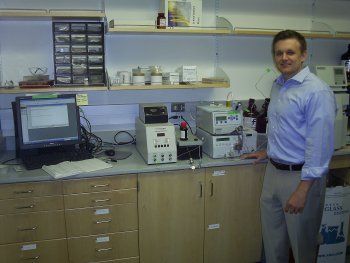The Viscotek multi-detector gel permeation chromatography (GPC) system from Malvern Panalytical is proving to be the ideal solution for researchers at The University of Texas at Austin whose work is taking them to the very limits of what can be achieved by GPC.
The research team from the Department of Chemistry and Biochemistry is using multiple Viscotek GPC instruments to help guide the development of new monomers and polymers for use in high performance solar cells.
 Prof. Christopher Bielawski and the Malvern Panalytical Viscotek system at The University of Texas at Austin.
Prof. Christopher Bielawski and the Malvern Panalytical Viscotek system at The University of Texas at Austin.
"We prepare many novel polymers and need the most powerful GPC technology available in order to fully characterize our materials," says Professor Christopher Bielawski. "The multiple detectors of the Viscotek system provide us with critical compositional, structural, and molecular weight information, particularly for some of our more challenging materials. Equally important, however, is the support we've received from Malvern Panalytical. Their GPC experts have helped us to find new and innovative ways to push the boundaries of the technique to new limits which have been beneficial for our studies."
Professor Bielawski's group synthesises new monomers, which are combined using a polymerization reaction to form new polymers that feature novel structures and useful properties. They frequently target very high molecular weight materials which are often only sparingly soluble in the solvents typically used for GPC analysis. Here, Malvern Panalytical has provided support by exploring the application of relatively exotic eluents to help the group establish new procedures to successfully acquire the information required.
The Viscotek TDA Max, is a complete, advanced, multi-detector GPC/size exclusion chromatography systems suitable for all macromolecules. It is configurable with a comprehensive range of detectors: refractive index; viscometry; light scattering (dynamic or static); and UV (single wavelength or PDA). Powerful OmniSEC software simplifies control of the whole system, combining the information from each detector to provide advanced characterization parameters.